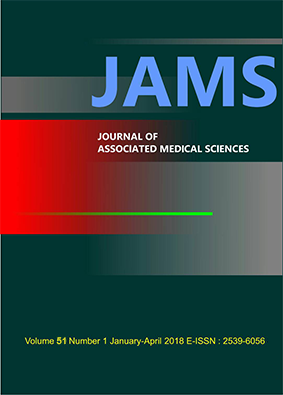Occupations after Stroke in Stroke Survivors’ and Their Family Caregivers’ Perception: Similarities or differences?
Main Article Content
Abstract
Background: Stroke is a leading cause of death and disability worldwide. Stroke survivors have to adapt to a life with restrictions on activities of daily living as a consequence of stroke. In Thai culture, family members generally take responsibility in providing help, care, and support to stroke survivors. Being family caregivers has been reported to be a burden. To equip families to promote better quality of life in stroke survivors in Thailand, an investigation of stroke survivors’ and their family caregivers’ perception on occupational performance after stroke is required.
Objectives: To examine and compare the perception among stroke survivors and their family caregivers on occupational performance of stroke survivors.
Materials and methods: Thirty stroke survivors living in the communities and their primary caregivers were recruited for the study. The 4th Edition Canadian Occupational Performance Measure (COPM) was used to assess stroke survivors’ self-perception on occupations. They were asked to identify a maximum of five activities that caused difficulty to stroke participants. Stroke participants’ performance and satisfaction of the reported activities were rated on a scale. The identified problems, and rated scores of performance and satisfaction were compared between two groups using Fisher’s exact test and Wilcoxon signed-rank test.
Results: After stroke, participants had difficulty performing occupations by themselves, especially in the area of self-care which included personal care, functional mobility, and community management. When comparing the individual pairs, most activities were reported differently. Only 46 activities out of 157 activities (29.3%) were identified by both groups. Their perceptions on performance, and satisfaction scores of the same activities were not statistically different. The results of the study indicated that there were some similarities and discrepancies between the perceptions of the stroke participants and their caregivers on occupations after stroke even though they had close relationship.
Conclusion: For better quality of life among stroke survivors in Thai culture, occupational therapists need to use the client-centered approach focusing on both stroke survivors and their family caregivers in promoting a deeper understanding of stroke survivors’ needs of care, what activity they cannot do by themselves and to what extent assistance is required.
Article Details
Personal views expressed by the contributors in their articles are not necessarily those of the Journal of Associated Medical Sciences, Faculty of Associated Medical Sciences, Chiang Mai University.
References
[2] Porapakkha Y, Rao C, Pattaraarchachai J, Polprasert W, Vos T, Adair T, and Lopez AD. Estimated causes of death in Thailand, 2005: Implications for health policy. Pop Health Metr 2010; 8(14): 1-11.
[3] Radomski MV, Trombly Latham CA. Occupational therapy for physical dysfunction. 7th ed. Philadelphia: Wolters Kluwer Health/Lippincott Williams & Wilkins; 2014.
[4] Christiansen CH., Baum CM. Occupational therapy: performance, participation, and well-being. 3rd ed. Thorofare, NJ: Slack; 2005.
[5] Zhang J, Lee DTF. Meaning in stroke family caregiving: a literature review. Geriatric Nursing 2017; 38(1): 48-56.
[6] Jullamate P, de Azeredo Z, Paul C, & Subgranon R. Thai stroke patient caregivers: who they are and what they need. Cerebrovascular Disease 2006; 21(1-2): 128-133. doi:10.1159/000090211.
[7] Ostwald SK, Bernal MP, Cron SG. Stress experienced by stroke survivors and spousal caregivers during the first year after discharge from inpatient rehabilitation. Top Stroke Rehabilitation 2009; 16(2): 93-104.
[8] Camicia M, Lutz BJ, Markoff N, & Catlin A. Determining the needs of family caregivers of stroke patients during inpatient rehabilitation using interview, art, and survey. Rehabil Nurs 2018; Jan 3: doi: 10.1097/RNJ.0000000000000129.
[9] Palmer S, & Glass TA. Family function and stroke recovery: a review. Rehabilitation Psychology 2003; 48(4): 255-65.
[10] Law M, Beptiste S, Carswell A, McColl MA, Polatajko H, & Pollock N. Canadian Occupational Performance Measure manual. Ottawa: CAOT Publication; 1999.
[11] Yang SY, Lin CY, Lee YC, Chang JH. The Canadian Occupational Performance measure for patients with stroke: a systematic review. J Phys Ther Sci 2017 Mar; 29(3): 548-55
[12] The American Occupational Therapy Association. Occupational therapy practice framework: domain and process. 3rd ed. Am J Occup Ther 2002; 56: 609-39.
[13] Reed K. Models of practice in occupational therapy. Baltimore: Williams & Wilkins; 1984
[14] Law M. Participation in the occupations of everyday life. Am J Occup Ther 2002; 56(6): 640-9.
[15] Scholte op Reimer WJ, de Haan RJ, Rijnders PT, Limburg M, & van den Bos GA. The burden of caregiving in partners of long-term stroke survivors. Stroke 1998; 29(8): 1605-11.
[16] Lutz BJ, Young ME, Cox KJ, Martz C, & Creasy KR. The crisis of stroke: experiences of patients and their family caregivers. Top Stroke Rehabil 2011; 18(6): doi: 10.1310/tsr1806-786.


